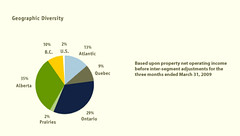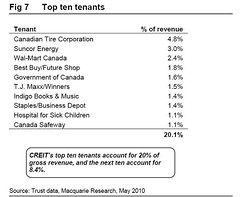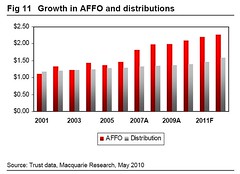Continuing with the stocks on our watch-list series, we will be highlighting a Real Estate Investment Trust (REIT) this week. REITs were introduced in Canada in 1993 and structured as tax efficient entities, such that they are not generally required to pay Canadian income tax if they distribute all of their net income for tax purposes on an annual basis to unitholders.
Our pick, Canadian REIT [REF.UN] is the oldest real estate investment trust in Canada and owns a high-quality diversified commercial portfolio of 160 properties totalling 18 million square feet (net ownership interest) of retail, office and industrial space.
Company Basics
CREIT’s assets have grown from $84 million in December 1994 to $2.2 billion in December 2008. As a consequence, the company’s annual distributions have grown from $0.58 per unit in 1994 to $1.41 per unit in 2010.
50% of CREIT’s income is generated from retail real estate assets with a focus on “proprietary” retail property. CREIT defines “proprietary” assets to mean assets that are both the ‘product of choice’ for tenants and that enjoy significant barriers to entry from new competitive product. In this “niche” sub-set of retail real estate, Management focuses on food-store-anchored, open-concept plazas and other unenclosed centres anchored by leading retailers, with long-term leases.
25% of CREIT’s income is generated from industrial properties (distribution facilities and buildings used for light manufacturing) of a size and configuration that will readily accommodate the diverse needs of a broad range of tenants.
The final 25% of CREIT’s income is generated from office buildings. Management’s focus is on large, well-located buildings in target cities. Office is the most volatile of CREIT’s three asset classes, both in terms of occupancy and rental rates. As a result, Management’s aim is to seek an institutional partner for each of the office assets, so that CREIT reduces its exposure to any one office tenant.
Canadian REIT [REF.UN] generates revenue from the following four principal sources:
- Property rental revenue, which includes rent paid by tenants for their leased premises, plus reimbursements or recoveries from tenants for property operating costs and realty taxes (“recoveries”) relating to their leased premises and the common property areas;
- Interest income generated from mortgage investment activity and cash balances in CREIT’s bank accounts;
- Fee income, which includes property management fees, leasing fees, and project management fees relating to co-owned properties, and other miscellaneous fees. Fee income serves as a cash flow supplement to enhance returns from co-owned assets. The generation of fee income is not viewed as a separate segment of business activity; and
- Lease termination income, which relates to payments received from tenants where CREIT agreed to cancel or terminate their lease prior to the contractual expiry date.
| Units Outstanding (fully diluted) | 66.4 Million |
| Price (as of 3:58 PM ET June 04, 2010) | C$27.83 |
| Market Capitalization | C$1.8 Billion |
| Annual Distribution/Yield | C$1.41/5.1% |
| 52 Week High/Low | C$29.49/C$22.44 |
Financials
For Q1/10, CREIT reported FFO*/unit of C$0.59 (excl. lease termination fees) beating the C$0.57 analyst consensus. This compared to C$0.61/u in 1Q09.
Same property net operating income (NOI) cash growth came in at 1.7% vs 0.0% in 1Q09.
Occupancy decreased 130 bps to 95.0% at Q1 from 96.3% a year ago and 95.6% at Q4/09 (down 60bps), with declines in each sector.
The weighted average cost of fixed debt was 5.3% and EBITDA interest coverage rose to a very strong 3.4x.
Distributions increased 2% to C$1.41/unit annualized (from C$1.38). Despite the increased distribution, CREIT maintains one of the lowest Adjusted Funds From Operations (AFFO) payout ratios among Canadian REITS at just 68% of 2010E.
CREIT’s debt/Gross Book Value (GBV) assets was 51.4% at Q1/10, down from 57.6% last year (mainly due to the REIT’s April 2009 C$100m equity financing) and well below the REIT’s maximum allowable limit of 60%, providing more than $500 million of acquisition capacity at 60%.
*FFO or funds from operations is an earnings measure developed for the public real estate industry.
Outlook and Future
In the Q1/10 Management’s Discussion & Analysis Of Results Of Operations And Financial Condition, it was reported that management anticipates a slow recovery in commercial real estate. Furthermore, management is of the view that the primary source of growth in earnings for 2010 will be through new acquisition activities if and when transacted.
It was also made known that CREIT is in the process of reorganizing its structure and certain operations to qualify as a REIT and maintain its tax exemption status. Management believes that CREIT will make the necessary changes to its structure in order to qualify for the REIT Exception before December 31, 2010.
Part of CREIT’s operating plan involves maintaining debt levels of up to 60% of total adjusted assets. Accordingly, CREIT does not generally repay maturing debt from cash flow, but rather with proceeds from refinancing such debt or financing unencumbered properties, and raises new equity by issuing units or “recycles” equity through property dispositions to finance investment activities.
Over the last 15 months, CREIT’s total assets have declined due primarily to property dispositions exceeding acquisition activities. Regardless, EBITDA has increased 3% for the three months ended March 31, 2010 when compared to the same period in 2009 due in part to positive same-asset property net operating income performance and lease termination income.
According to CIBC World Markets analyst Alex Avery:
“CREIT’s low-leverage and high-quality, defensive portfolio should continue to deliver stable and consistent operating results in 2010, including stable occupancy, high tenant retention, and relatively unchanged same-portfolio NOI.
The REIT is very well positioned to acquire property with high liquidity and substantial additional debt capacity. However, due to a lack of large, highquality
real estate assets for sale, and considerable competition for those that are for sale, we expect it could be a few quarters or more before CREIT deploys its enviable financial resources. We expect management to be patient and discriminating in its pursuit of high-quality assets consistent with its current portfolio, and at pricing deemed appropriate by management. In the interim, the REIT’s lower leverage will have a dilutive impact on CREIT’s FFO and AFFO.”
The aforementioned details were an oversimplified snapshot of the details behind Canadian REIT [REF.UN]. Due to time and space constraints, there is an immense amount of information that has not been included in this article. Please do your own due diligence and consult with a qualified financial advisor before making any investment decisions.
Earnings & Price Target
Reacting to CREIT’s Q1/10 earnings, Macquarie analyst Michael Smith pegged the company’s Net Asset Value (NAV) at C$25.75 and maintained his target price at C$30.00. Smith further opines that:
“CREIT’s valuation is attractive as it trades at 6% premium to NAV vs peers at 11%. Given its strong balance sheet, conservative payout/debt ratios, and diversified portfolio (asset class/geography), CREIT represents a good risk reward profile, and we believe long-term investors will be rewarded.”
On the day of Smith’s note, May 7/10, Canadian REIT [REF.UN] was trading at C$27.41.
Also reacting to CREIT’s Q1/10 earnings, CIBC World Markets analyst Alex Avery pegged the company’s NAV at C$27.25. In coming up with his price target, Avery states:
“At $27.41, CREIT trades at 11.6x 2010E FFO, a modest 1% premium to our $27.25 estimate of NAV (at a 7.25% cap rate from $26.50 at a 7.25% cap rate) and yields 5.1% (68% 2010E AFFO payout ratio). Our 12- to 18-month price target is 12.0x-12.5X 2010E FFO or approximately $29.00 (unchanged), implying a total return of approximately 11%. We continue to rate CREIT Sector Performer reflecting its very defensive capital and financial structure, high quality portfolio and conservative management team.”
Risks
Risks include the potential for an unanticipated increase in interest rates, for unexpected deterioration in commercial space leasing conditions and for diversion of investors’ capital flows away from high-yielding real estate equities towards other asset classes.
Did you like this article? Let us know your thoughts and suggestions in the comments below.











